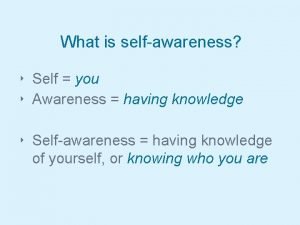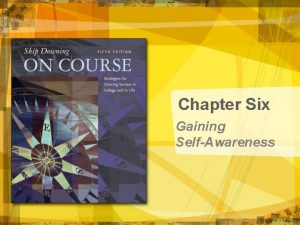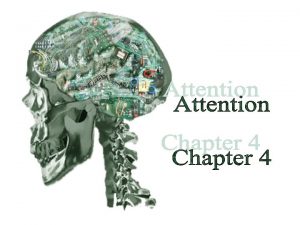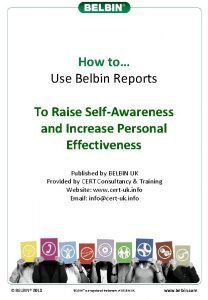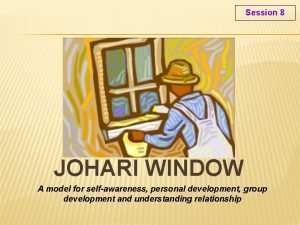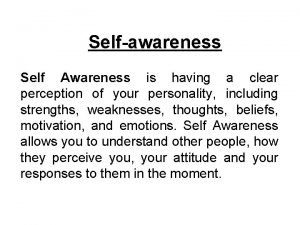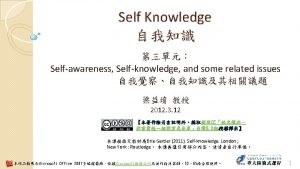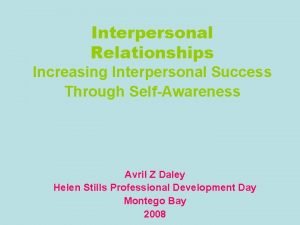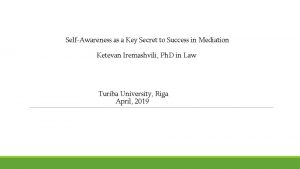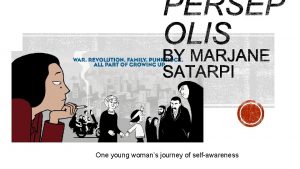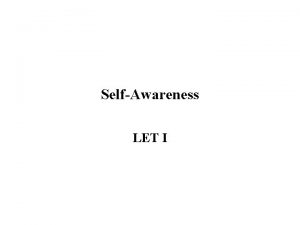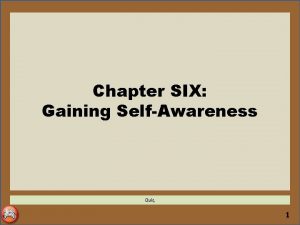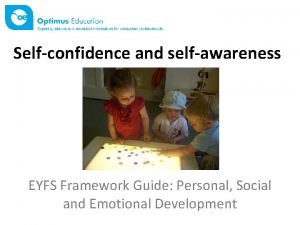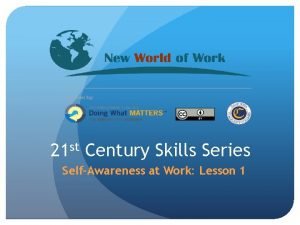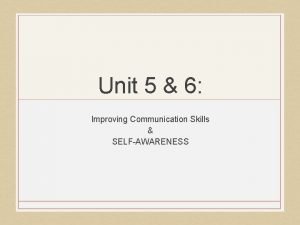MODULE 1 SELFAWARENESS OUTLINE FOR THIS MODULE Who

















































- Slides: 49

MODULE 1: SELF-AWARENESS

OUTLINE FOR THIS MODULE Who are Community Health Workers? Cultural Humility Self-Awareness, Conflict and Boundaries Review and Assessment

WELCOME AND INTRODUCTIONS Please share your: Name. Hometown. Experience with CHWs. What do you want from this class?

ICE BREAKER GAME

Brainstorm Together: Classroom Norms and Expectations

WHO ARE COMMUNITY HEALTH WORKERS?

LEARNING OBJECTIVES By the end of this section, you will be able to: Describe CHWs and what they do. Identify where CHWs work, the populations they work with and the health issues they address. Explain the core roles that CHWs play in the health and social service fields. Discuss the core competencies that CHWs use to assist individuals and communities. Describe personal qualities and attributes that are common among successful CHWs. Discuss emerging models of care and opportunities for CHWs.

WHO ARE CHWS? CHWs work with diverse communities at risk for illness, disability and death. CHWs reduce health inequalities in the rates of illness, disability and death among different communities.

WHAT ARE CHWS’ RESPONSIBILITIES? Outreach. Home visits. Case management. Health education. Informal counseling. Advocacy. Community organizing.

COMMON TITLES FOR CHWS Case manager / case worker. Health educator. Community health advocate. Health worker. Community health outreach worker. Lay health advisor. Community outreach worker. Public health aide. Community liaison. Patient navigator. Community organizer. Peer counselor. Enrollment specialist. Peer educator. Health ambassador. Promotor/a.

CHWS’ GENDER, ETHNICITY, EDUCATION AND BACKGROUND 82% are female between the ages of 30 and 50. 35% are Hispanic; 39% are Caucasian; 15% are African American. 35% have high school diplomas. 20% have some type of college. 31% have a four-year degree.

CHWS FIVE MODELS OF CARE 1. Member of a healthcare delivery team. 2. Navigator. 3. Screening and health education. 4. Outreach / enrolling / informing agent. 5. Organizer.

CORE ROLES Cultural mediation. Informal counseling. Direct services and referrals. Culturally appropriate health mediation. Advocacy. Assuring people get services. Capacity building.

CHW CORE COMPETENCIES 1. Communication skills. 2. Interpersonal skills. 3. Knowledge base. 4. Service coordination skills. 5. Capacity-building skills. 6. Advocacy skills. 7. Teaching skills. 8. Organization skills.

CORE COMPETENCIES Self-awareness Awareness of own emotional and behavioral responses. Recognition and ability to explain how an individual’s culture, beliefs or values affect behavior. Service Coordination and System Navigation Assist health care providers to coordinate care. Help clients understand use health and community-based services appropriately. Bridge cultural, linguistic, knowledge and literacy differences among individuals, families, communities and providers. Educating to Promote Healthy Behavior Change Provide people with information, tools and encouragement to help them improve their health and stay healthy. Advocacy Individual and Community Capacity Building Working with or on behalf of people or communities to exercise their rights and gain access to resources. Helping people or communities develop the confidence and ability to make decisions and seek resources that affect their health. Promoting individual and collective empowerment through education, skill development, networking, organizing, and strategic partnerships.

CORE COMPETENCIES Individual and Community Capacity Building Effective Communication Strategies Cultural Responsiveness Documentation and Reporting Helping people or communities develop the confidence and ability to make decisions and seek resources that affect their health. Promoting individual and collective empowerment through education, skill development, networking, organizing and strategic partnerships. Listening carefully and communicating respectfully in ways that are meaningful to the individual. Includes listening, speaking, gathering and sharing information, resolving conflict and checking for understanding. Understand beliefs, values, customs and social behavior shared by a group of people with common identity. Act as cultural mediators between health and human service system. Document your work activities, including writing summaries of individual and community assessments accurately. Able to present information to colleagues or organizational partners while maintaining confidentiality.

CORE COMPETENCIES Professionalism and Conduct Use of Public Health / Community Health Concepts and Approaches Individual Assessment Community Assessment, Identify Barriers and Resources Skills to handle ethical challenges, confidentiality and privacy rights. Professional boundaries and working collaboratively in an organization. Identify health disparities related to social justice issues. Identify evidence-based methods and promote those to prevent injury and disease. Promote health equity and efforts to reduce health disparities through engagement with others. Engage in systematic problem solving — including assessment, information gathering, goal setting, planning, implementation, evaluation and documentation. Assess barriers to accessing health care and other services. Help people to identify their goals, barriers to and supports for change. Continue assessment as an on-going process. Identify barriers to accessing health care within a community. Share results with partners to develop outreach plans.

CHW PERSONAL QUALITIES Interpersonal warmth. Trustworthiness. Open-mindedness. Objectivity. Sensitivity. Competence. Commitment to social justice. Good psychological health. Self-awareness and understanding.

CHWS IN THE MANAGEMENT OF CHRONIC CONDITIONS The Affordable Care Act and the “triple aim. ” The context of chronic disease in the United States. CHW role on a health care team: Improve health outcomes. Reduce costs. Improve patient experience.

PROFESSIONALIZING THE CHW FIELD Strategies to advance the field: Research on CHW interventions. CHW associations / networks. Credentialing / certification. Training programs / materials. Funding policy and models.

GROUP ACTIVITY 1. 1 ROLES, COMPETENCIES AND CHARACTERISTICS OF CHWS

GROUP ACTIVITY 1. 2 IDENTIFYING CHARACTERISTICS OF SUCCESSFUL CHWS

ACTIVITY 1. 3 PANEL OF CHW GUEST PRESENTERS

CULTURAL HUMILITY

LEARNING OBJECTIVES By the end of this section, you will be able to: Define the concept of cultural humility. Describe the changing population in the United States and how this affects the work of CHWs. Discuss how historical and institutional discrimination affects the health of targeted communities and influences their work with public health providers. Analyze the importance of becoming lifelong learners and practitioners of cultural humility. Discuss and analyze concepts of traditional health beliefs and practices and how they may influence the deliver of services to clients. Create a personal learning plan in order to become a culturally effective CHW.

ACTIVITY 6. 1 INTRODUCTION TO CULTURAL HUMILITY

DEFINING CULTURAL HUMILITY Cultural humility is a guide that emphasizes understanding power relationships and cultural identities. Cultural humility is being flexible enough to: Engage in self-reflection and self-critique. Understand that all cultures deserve our respect. Admit when you don’t know the culture or social context of clients. Use resources that broaden understanding of cultures in the communities you serve. Recognize that the client is the expert of his/her own culture, values and beliefs. Put assumptions aside when working with clients. Ask clients to share their own experiences, knowledge and resources so that you can support their health and well-being.

STRUCTURAL RACISM Structural racism: inequities are built into the education, legal, employment, housing and health care systems. Racial discrimination results in poorer health outcomes.

DISCRIMINATION IN PUBLIC HEALTH Tuskegee study. Forced sterilizations. LGBTQ discrimination.

DEFINING CULTURE Culture includes beliefs, behaviors, attitudes and practices that are learned, shared and passed on by members of particular group. Culture is not static. It is dynamic, constantly changing and evolving with us. Culture includes ethnic identity, immigration status and experience, sexual orientation, gender identity, religion or spirituality, social class, family background, language, physical ability, traditions, etc.

IN THE UNITED STATES… 40. 8 million immigrants; an estimated 11 million are undocumented. Most Latinos living in the United States were born here. Most immigrants are from China, India, Mexico and the Philippines. Where were your grandparents and their parents born? Where are your neighbors, friends and co-workers from? Where are your doctor, mechanic and teachers from? What are the languages, cultures or other identities of your fellow students?

SELF-AWARENESS How do you identify culture? What do believe are key components of culture? How does culture impact values and beliefs? Is culture explicit or implicit? Is your culture inherited or learned? What is your culture?

SELF-AWARENESS Cultural humility is a life-long process. Be aware of your own tendencies. Be willing to challenge your own assumptions. Understand your position of power. Remain client-centered and not controlling of client.

THE LEARN MODEL L― Listen with sympathy and understanding to the client’s perception of the problem. E― Explain your perceptions of the problem. A― Acknowledge and discuss the differences and similarities between your perceptions and that of the client. R― Recommend resources. N― Negotiate agreement.

CULTURE & HEALTH BELIEFS Culture specific fears and stigmas. Common myths and misinformation. Use of alternative or complementary medicine.

ACTIVITY 6. 2 CULTURAL HUMILITY VIDEO DISCUSSION

ACTIVITY 6. 3 CULTURAL HUMILITY ROLE PLAY

GUEST PRESENTATION ANTI-RACISM TRAINING / PRESENTATION

SELF-AWARENESS, CONFLICT AND BOUNDARIES

LEARNING OBJECTIVES Define self-awareness. Explain the importance of self-awareness to the work of CHWs. Identify practical strategies for enhancing self-awareness. Discuss the importance of understanding personal and cultural conflict styles and become more familiar with your own conflict style. Discuss the importance of self-reflection and evaluation to becoming a skilled group facilitator and apply this to your work.

WORDS TO KNOW Self disclosure. Self awareness. Professional boundaries.

THE VALUE OF SELF-AWARENESS When your issues are present, you may not be aware that they are influencing your ability to work with others. You may unconsciously guide, direct or pressure clients to talk about or avoid certain topics, to make choices that are more about your own needs than those of the client.

THE VALUE OF SELF-AWARENESS Developing self-awareness is a lifelong task to better understand yourself, including life experiences, values and beliefs and prejudices. Ways to improve self-awareness: Counseling. Talking with family and colleagues. Professional development. Writing / journaling.

SELF-EVALUATION Ask yourself the questions found on page 172 -173 in the textbook. Discuss any surprising answers with your neighbor.

PERSONAL CONFLICT STYLES Avoiding. Accommodating. Competing. Compromising. Collaborating.

SELF-AWARENESS AND BOUNDARIES Being aware of personal aspects will help you be present with your patients / clients. Signs that your issues are disruptive to your work: Not listening to others. Strong emotional reactions. Avoiding topics, people or dynamics. Making assumptions. Paying less attention to some clients. Strong desire to share personal information.

ACTIVITY 7. 5: BUILDING SELF-AWARENESS

REVIEW – WHAT HAVE WE LEARNED TODAY?

SERVICE LEARNING
 What is selfawareness
What is selfawareness Sandwich quotation
Sandwich quotation Presentera för publik crossboss
Presentera för publik crossboss Rbk fuktmätning
Rbk fuktmätning Kontinuitetshantering i praktiken
Kontinuitetshantering i praktiken Myndigheten för delaktighet
Myndigheten för delaktighet Kung dog 1611
Kung dog 1611 Tobinskatten för och nackdelar
Tobinskatten för och nackdelar Tack för att ni har lyssnat
Tack för att ni har lyssnat Referatmarkering
Referatmarkering Boverket ka
Boverket ka Karttecken ruin
Karttecken ruin Luftstrupen för medicinare
Luftstrupen för medicinare Varför kallas perioden 1918-1939 för mellankrigstiden?
Varför kallas perioden 1918-1939 för mellankrigstiden? Arkimedes princip formel
Arkimedes princip formel Större och mindre tecken
Större och mindre tecken Elektronik för barn
Elektronik för barn Borra hål för knoppar
Borra hål för knoppar Bra mat för unga idrottare
Bra mat för unga idrottare A gastrica
A gastrica Smärtskolan kunskap för livet
Smärtskolan kunskap för livet Bris för vuxna
Bris för vuxna Vad är ett minoritetsspråk
Vad är ett minoritetsspråk Typiska drag för en novell
Typiska drag för en novell Frgar
Frgar Autokratiskt ledarskap
Autokratiskt ledarskap Ellika andolf
Ellika andolf Rita perspektiv
Rita perspektiv Toppslätskivling dos
Toppslätskivling dos Debatt mall
Debatt mall Redogör för vad psykologi är
Redogör för vad psykologi är En lathund för arbete med kontinuitetshantering
En lathund för arbete med kontinuitetshantering Gumman cirkel sång
Gumman cirkel sång Bästa kameran för astrofoto
Bästa kameran för astrofoto Lyrik
Lyrik Etik och ledarskap etisk kod för chefer
Etik och ledarskap etisk kod för chefer Publik sektor
Publik sektor Antika plagg
Antika plagg Vilken grundregel finns det för tronföljden i sverige?
Vilken grundregel finns det för tronföljden i sverige? Bamse för de yngsta
Bamse för de yngsta Densitet vatten
Densitet vatten Ministerstyre för och nackdelar
Ministerstyre för och nackdelar Sju principer för tillitsbaserad styrning
Sju principer för tillitsbaserad styrning Kanaans land
Kanaans land Tack för att ni lyssnade bild
Tack för att ni lyssnade bild Nyckelkompetenser för livslångt lärande
Nyckelkompetenser för livslångt lärande Romarriket tidslinje
Romarriket tidslinje Verksamhetsanalys exempel
Verksamhetsanalys exempel Gibbs reflekterande cykel
Gibbs reflekterande cykel Matematisk modellering eksempel
Matematisk modellering eksempel
